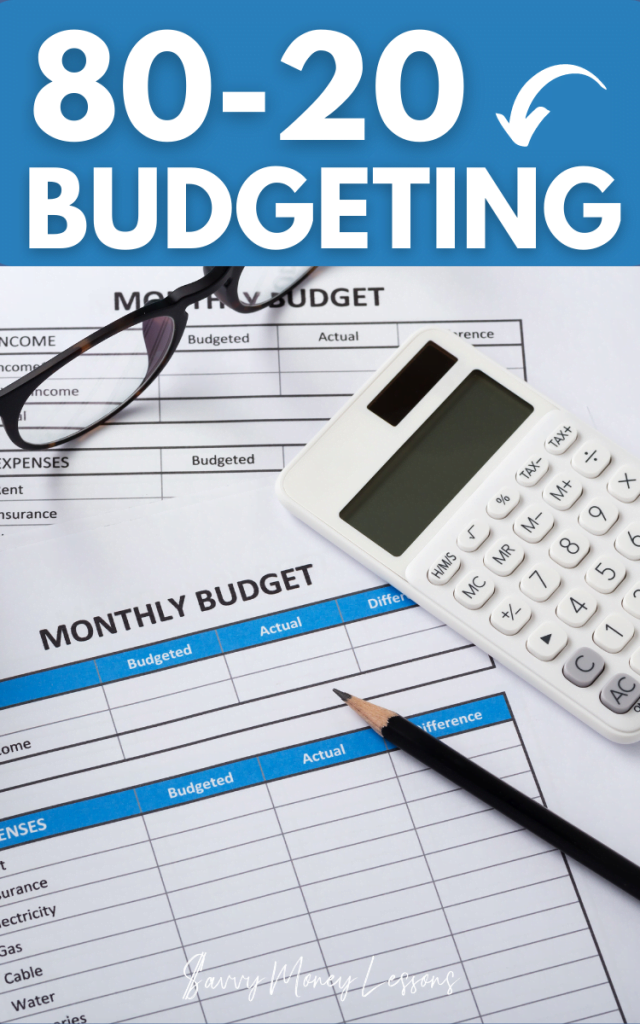70 20 10 Budget Rule [How 70-20-10 Budgeting Works]
This post may contain affiliate links, which means I may earn a small commission if you click and make a purchase. You can read our full disclosure policy here.
Last Updated on July 1, 2023 by Rebecca
Need a new way to budget? The 70 20 10 budget method is a simplified way to divide your monthly income.
With this budgeting system, you divide your after-tax income into three different categories: spending, saving and debt repayment/giving.
If you’ve struggled with finding the right budgeting method, a 70/20/10 budget system can be a good way to manage monthly spending while working toward your financial goals. Keep reading to learn how the 70-20-10 rule works and why it might just be the simplest way to make a monthly budget.

Want free money?
Check out my favorite apps for making extra money and earning cash back!
Survey Junkie. Earn up to $50 per survey for sharing your opinions
Swagbucks. Make money playing games and watching videos ($5 bonus!)
InboxDollars. Take surveys and get paid for your opinions
Rakuten. Earn up to 40% cash back, plus get $30 for each person you refer
CashApp. Get $5 free when you use code ‘VZXRXZN’ to join CashApp
Writers Work. Earn extra cash from your writing skills!
Table of Contents
What Is the 70 20 10 Budget Rule?

A 70/20/10 budget is a percentage-based budgeting method that divides your income into three buckets. Here’s what the budget percentages look like:
- 70% for monthly expenses
- 20% for saving and investing
- 10% for debt repayment and giving
You may see the second two categories interpreted a little differently by other sources.
For example, some financial experts recommend that you split the 20% category between saving and debt while reserving the last 10% for investing. Or they might suggest that you allocate 20% to debt and 10% to saving and giving.
Whether it makes sense to choose a slightly different allocation can depend on your financial situation, how much money you want to save, invest or give away, and how much debt you’re carrying.
The great thing about the 70-20-10 budget is that like other budgeting rules, it allows for some flexibility when planning how to spend money each month.
Related post: Importance of a Family Budget and How to Make One
How a 70/20/10 Budget Works
A 70 20 10 budget system works by having you add up your income for the month and split it into three categories. From this point on, we’ll assume that you have one category for living expenses, one for saving and investing and a third for paying off debt.
Here’s a closer look at what’s included in each of those categories
70% for spending
Following the 70-20-10 budgeting rule, the largest per cent of your income should go to living expenses. That includes fixed expenses, variable expenses and discretionary spending.
Now, what’s the difference?
Fixed expenses are monthly expenses that are usually the same amount all the time. These expenses are easier to budget for, since they don’t change.
Variable expenses can increase or decrease from month to month. So you might pay more or less, which can make budgeting for these expenses a little trickier.
Discretionary spending is anything that you spend money on that isn’t a bill. In other words, this is your “fun” money in your budget.
Fixed expenses examples
If you’re new to budgeting, you might not know the difference between fixed vs. variable expenses. Examples of fixed expenses can include things like:
- Mortgage payments
- Rent payments
- Car insurance
- Health insurance
- Subscription services
- Gym memberships
- Child care
- Medications or other recurring medical costs
There’s another distinction to make here between wants and needs when you’re talking about fixed expenses.
Rent or mortgage payments are “needs” because if you don’t pay them, you won’t have a place to live. Subscription services or a gym membership, on the other hand, is usually a need since you can technically do without those things.
Variable expenses examples
Now that we’ve covered fixed expenses, let’s go over some examples of variable expenses. The list can include:
- Utility bills, if your energy or water usage fluctuates throughout the year
- Groceries
- Gas and transportation costs
- Clothing
- Personal care
- Household items
- Entertainment and hobbies
- Travel
- Kids’ activities
- Recreation
- Dining out
Variable costs can be harder to budget for since you might spend a little money in a particular category one month and a lot the next. This budget category can also include one-time impulse buys.
Most of your “wants” or discretionary spending will usually be in this budget category since things like dinner out or a weekend trip typically aren’t necessities.
20% to saving and investments

The second category used in the 70-20-10 budgeting method is reserved for saving and investing. Where you decide to keep this money can depend on your financial situation and goals, but it might include:
- A high-yield savings account
- Money market savings accounts
- Certificate of deposit (CD) accounts
- A taxable investment account
- Traditional or Roth IRAs
- College savings accounts
What’s the best way to save money? It really depends on your reasons for saving.
Keep your emergency fund in a savings account
Having a rainy day fund is a huge help if you run into an unexpected expense. You can tap into your savings vs. having to use a credit card or get a loan to pay for it.
Where is the best place to keep emergency savings?
High yield savings accounts at online banks are a good option for holding an emergency fund. They typically earn higher interest rates than savings accounts offered by brick-and-mortar financial institutions.
How much should you save for emergencies? If you’re just getting started with saving, then a $1,000 baby emergency fund is a good goal to aim for. From there, you can work on saving three to six months’ worth of expenses.
Grow your money faster! Want to get a great rate on your savings? Open a high-yield savings account to earn the most competitive APY on deposits.
Adding sinking funds to the savings category
Sinking funds let you save money for expenses you pay periodically, instead of monthly. So, you might pay these expenses quarterly, biannually or yearly.
Including sinking funds in the savings portion of a 70 20 10 budget can be a smart move if you don’t want to be caught off-guard when those bills come due. By saving for them regularly out of your monthly budget, you can have the money to pay for them when the time comes.
You might include the following categories when building sinking funds into your budget:
- Car insurance premiums
- Property taxes, HOA fees or homeowners insurance if those expenses aren’t escrowed into your mortgage payment
- Kids’ activities, such as summer camp, class trips or back to school shopping
- Annual home maintenance, such as HVAC servicing or pest control
- Pet care, including annual vaccinations and other required health care
- Estimated quarterly taxes if you’re self-employed
- Wedding expenses
- Birthdays and gifts
- Holiday shopping
- College tuition payments
- Other special occasions, like anniversaries, graduations, etc.
Invest money for retirement
When you save money, you’re putting it into a bank account or another low-risk savings vehicle. You might earn some interest on your savings and the odds of losing money are virtually zero.
Investing, on the other hand, means putting money into the stock market or other financial products that are designed to generate higher returns through the power of compound interest.
For example, if you’re hoping to build a nest egg for retirement then you might open an Individual Retirement Account or contribute to a 401(k) at work. Or you might set up a taxable investment account to trade stocks, mutual funds or even cryptocurrency.
Investing wisely can help you get closer to financial freedom if you’re able to produce consistent returns. The trade-off is that investing is riskier than saving and there’s always a chance that you could lose money.
Set aside money for college savings
If you have kids, saving money for college can help them avoid having to take out loans later when it’s time for them to earn a degree. There are a few different options for college savings, including:
- Savings accounts or CD accounts
- Money market accounts
- Coverdell Education Savings Accounts
- 529 plans
The best option overall is usually a 529 plan, at least from a tax standpoint. A 529 college savings plan doesn’t offer any type of federal tax deduction, but some states do have tax breaks for contributions.
Even better, the money you contribute grows tax-deferred. If you withdraw it to pay for qualified higher education expenses, it’s tax-free. Those are great reasons to consider opening a college savings account for your kids.
Pro tip: Struggling to stay on top of expenses? Consider using a personal finance tool like Empower to track all of your financial accounts in one place.
10% to debt repayment and giving

If you have consumer debt, the final 10% of your budget would be dedicated to repaying it. You’d include the following categories of debt would go here:
- Credit card debt
- Personal loans
- Student loans
- Car loans
- Other high-interest debt, such as installment loans or payday loans
- Mortgage loans
- Debts you owe to friends and family
Is 10% of income enough when you’ve got a lot of debt? It depends on how much you make.
If you’re on a tight budget, then 10% might be all you can spare. On the other hand, if you make a lot of money you might be able to make extra payments on top of the monthly payments you’re already making.
Pro tip: Transferring high-interest rate credit debt to a card with a 0% APR could save money and help you pay off debt faster. You can easily compare balance transfer offers on CreditKarma.
Debt snowball method
If you have extra debt you’re trying to unload with the 70 20 10 budget, then it helps to have a plan. The debt snowball method is a popular debt payoff strategy.
Here’s how it works:
- Order your debts from lowest balance to highest
- Put as much extra money as you can toward the smallest debt balance, while making minimum payments to everything else
- Once you pay off the first debt, add its payment to the minimum due for the next debt on the list
- Rinse and repeat until all debts are paid off
The debt snowball method can be a great way to maintain momentum while paying down credit cards. Knocking out one or two smaller debts right off the bat can help you stay motivated once it’s time to tackle your larger debts.
Debt avalanche method
The debt avalanche is a variation on the debt snowball and it largely works the same way, with one exception. Instead of ordering debts from the lowest balance to the highest, you rank them from the highest interest rate to the lowest.
Why?
It’s simple. Paying off your most expensive credit card bill first can save you more money on interest over the long term.
The debt avalanche may take longer to complete if you’re trying to pay down higher balances that also have higher rates. But it could be a good fit if you want to cut down on your total interest paid.
Including giving as part of your budget plan
If you don’t have debt or of your debt payments don’t eat up the full 10% of your budget that you’re allocating, you could give that money to a good cause instead.
How you give is up to you. If you go to church regularly, then you might tithe 10% of your take-home pay each week.
If not, then you might choose one or two charities to donate to locally or online. And if you’re planning to claim any charitable donations you make for a tax deduction, remember to get a receipt showing what you donated and where the money went.

Ready to get your budget together?
Grab our monthly budget worksheet, spending tracker and debt repayment tracker when you join the Savvy Money Lessons email list!
How to Set Up a 70 20 10 Budget
If you’re ready to give the 70/20/10 budgeting method a try and take control of your money, it’s pretty easy to do. Here’s how to put this budget rule to work.
Step 1: Add up your net income
Here’s a basic personal finance rule for making any budget: always use your post-tax income or take-home pay.
If you’re budgeting based on gross income instead of net, you’re putting yourself at a disadvantage because that isn’t the amount of money you’ll actually have to work with once taxes and other deductions are taken out.
Using your take-home income ensures that you have a realistic number to work with from the start.
You can find your net income listed on your pay stubs, along with any amounts deducted from your gross pay. If you’re self-employed, then you can figure your net income by subtracting any business expenses you pay and money you set aside for taxes from your total income.
Step 2: List all of your living expenses
If you’ve completed the first step and know how much money you have to work with, the next step is adding up all of the expenses that will go into the 70% category of your budget.
Again, that can include things like:
- Rent or mortgage payments
- Utilities
- Groceries and food
- Transportation costs
- Discretionary spending
If you’re not sure how much you spend each month in these categories there’s a simple way to find out.
You can download statements for your checking account and credit cards for the past three to six months, then review them to see where your money goes.
The key is to make sure you’re including every single expense you have each month. And if you want to automate the process, you can always use a free tool like Empower to keep track of your budget.
Pro tip: Struggling to stay on top of expenses? Consider using a personal finance tool like Empower to track all of your financial accounts in one place.
Step 3: Allocate your savings
If you’re saving 20% of your income each month, it might not all go to the same place. At this stage of the budgeting process, you’ll need to figure out where you want that money to go.
For example, say that you have $1,000 a month to save. You might divide it up in the following manner:
- $500 to an IRA for retirement
- $300 to your emergency account
- $100 to sinking funds
- $100 to college savings
There are lots of different ways you can divide up funds for savings and investments. And if you struggle to save each month, automatic deposits are a lifesaver.
Scheduling an automatic transfer from your checking account to a high yield savings account, for example, is an easy way to grow your emergency fund.
Step 4: Pay down debts
Last but not least, you’ll need to decide how you want to apply the 10% of your income that’s set aside for debt repayment.
There’s no hard and fast rule for how you do this.
For example, if you’re sick and tired of making car payments you might decide to prioritize them over student loan payments, especially if your car loan has a higher interest rate.
Or you might focus on paying off credit cards first if they’re costing you the most money in interest.
The key is to find an allocation that allows you to make progress in paying down debt so that you’re not stressing over money each month.

Pros and Cons of the 70 20 10 Budget
Like any budget system, the 70/20/10 method has advantages and disadvantages.
If you’re wondering whether it might be right for you, here are some of the main pros and cons to know.
70 20 10 budget pros
- Simplicity. The 70-20-10 budget rule is an easy way to manage money. You can use this budgeting system at any income level; all you need to be able to do is make some simple mathematical calculations.
- Flexibility. The 70 20 10 rule budget can be modified, depending on how much money you want to dedicate to saving, investing, debt repayment or giving.
- Goal-focused. Saving, investing and paying off debt are key to achieving financial stability. The 70/20/10 budget can help you approach money management with those goals in mind.
70-20-10 budget cons
- May be too simple for some. If you prefer a more detailed budget, then the 70/20/10 method may not work for you. This budgeting system is designed for people who prefer an uncomplicated approach.
- Needs vs. wants. The 70 20 10 budget doesn’t distinguish between needs and wants. Instead, all of your expenses are lumped in together, with saving and debt in their own categories.
- Irregular income. A 70-20-10 budget may be harder to complete if your income isn’t the same from month to month. One possible fix is using an average income to budget each month though that might not work for everyone.
70 20 10 Budget Example

If you’re new to 70 20 10 budgeting, having an example to follow can make it easier to decide if it’s right for you.
Here’s how a 70/20/10 budget might work if you have $5,000 per month in take-home pay.
70% of income for living expenses ($3,500)
- $1,500 for mortgage/rent
- $200 for electric and water
- $600 for groceries
- $200 for transportation
- $75 for cell phone
- $75 for internet
- $100 for car insurance
- $100 for health care
- $200 for entertainment and recreation
- $400 for child care
- $50 for streaming services
20% of income for saving/investing ($1,000)
- $500 to a Roth IRA
- $200 to emergency savings
- $100 to sinking funds
- $100 to college savings
- $100 to new car fund
10% of income for debt repayment ($500)
- $300 for student loans
- $100 for credit card A
- $100 for credit card B
Those are just examples of how you might divvy up your monthly income. Again, you could play around with the numbers if you’d like to put more money to debt repayment or more toward investing/saving.
70 20 10 Budget Template
Ready to try the 70/20/10 system for budgeting? This free budgeting template can help you get started!

Ready to get your budget together?
Grab our monthly budget worksheet, spending tracker and debt repayment tracker when you join the Savvy Money Lessons email list!
Bottom line: Is the 70 20 10 budget right for you?
The 70 20 10 budget rule can be an effective way to spend, save, invest and pay off debt. However, it’s not the only way to budget. You might try the 30 30 30 10 budget instead or the 10 10 80 budget, depending on your goals. Experimenting with different budgeting methods can help you find the right one for your needs.
Need more money tips? Read these posts next:
- 80/20 Budget: How to Apply This Simple Budgeting Rule
- How to Make a Budget in 5 Easy Steps
- Cute Budget Worksheets for Kids (6 Free Budget Printables!)
Have you tried the 70 20 10 budget?
About the Author
Rebecca is a certified educator in personal finance (CEPF) and a money-saving expert. As a single mom of two teens, she knows all about the importance of family budgeting and financial goal-setting. She shares her best tips about saving and managing money at Savvy Money Lessons. You can also read her work online at Bankrate, Forbes Advisor, Investopedia and other top publications. Learn more


![100 Envelope Challenge Chart [Free Printable Savings Tracker!]](https://savvymoneylessons.com/wp-content/uploads/2022/04/Savvy-Money-Lessons-Pins-640x1024.jpg)

![Gardening to Save Money [8 Smart Tips to Cut Your Food Budget!]](https://savvymoneylessons.com/wp-content/uploads/2021/06/Gardening-Tips-to-Save-Money-640x1024.jpg)



4 Comments